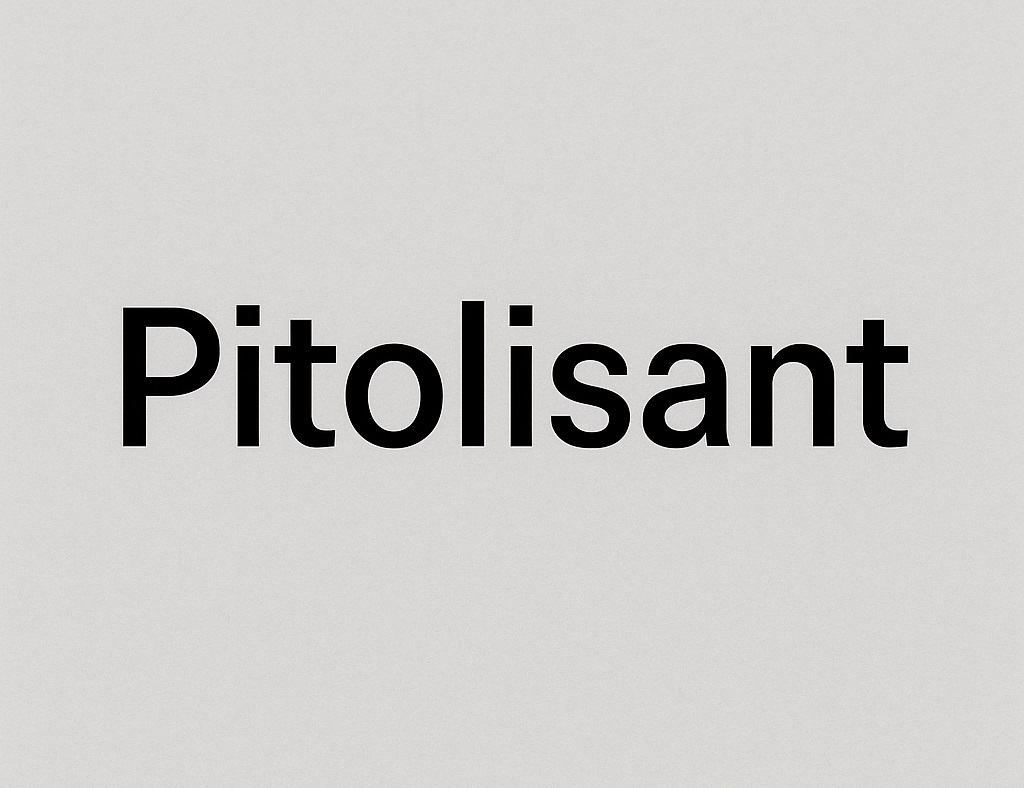In the world of wakefulness-promoting agents, Pitolisant represents a distinctive and innovative pharmacological class. Unlike common stimulants or dopamine-targeting drugs like modafinil or amphetamines, pitolisant acts on the histaminergic system, a relatively underutilized but vital regulator of arousal, cognition, and alertness.
Initially developed in France and now approved in multiple countries, pitolisant (brand name: Wakix) has become a go-to therapy for treating excessive daytime sleepiness (EDS) and cataplexy in narcolepsy. But its pharmacological uniqueness and favorable safety profile are now drawing broader interest from clinicians and researchers alike.
What Is Pitolisant?
Pitolisant hydrochloride is a first-in-class selective histamine H3-receptor antagonist/inverse agonist. This means it enhances the release of histamine in the brain, thereby indirectly promoting wakefulness and increasing the release of other key neurotransmitters like norepinephrine, acetylcholine, and dopamine.
Key Properties:
- Non-scheduled (not a controlled substance in many jurisdictions)
- Non-stimulant mechanism
- Long half-life (~10–12 hours)
- Minimal abuse potential
- Available as oral tablets, typically in 4.5 mg, 9 mg, and 18 mg strengths
How It Works: The Histamine Advantage
Unlike modafinil or traditional stimulants that primarily enhance dopamine, pitolisant targets the H3 autoreceptors in the central nervous system. These receptors normally inhibit histamine release. By blocking these inhibitory receptors, pitolisant increases histamine levels — leading to greater arousal, alertness, and improved attention.
This histamine-mediated action distinguishes pitolisant as a true eugeroic, not a stimulant. It enhances wakefulness without inducing hyperactivity, addiction, or rebound sleepiness.
Clinical Uses of Pitolisant
1. Narcolepsy
- Approved by the European Medicines Agency (EMA) and the U.S. FDA (as Wakix)
- Effective for both excessive daytime sleepiness and cataplexy
- Can be used in monotherapy or as an adjunct to other narcolepsy treatments
2. Idiopathic Hypersomnia (IH)
- Off-label use in some regions
- Clinical trials suggest positive effects on alertness and fatigue
3. Obstructive Sleep Apnea (OSA)–related Sleepiness
- Studied in patients with residual daytime sleepiness despite CPAP
- May provide an alternative to modafinil or solriamfetol
4. Parkinson’s Disease and ADHD (Investigational)
- Emerging research points to cognitive and attentional benefits, especially in populations affected by dopamine dysregulation
User Experiences Beyond Reddit
Drugs.com users (25 reviews, average rating ~5.3/10):
“This medicine changed my life… without feeling overactive and causes an increase in heart rate or my blood pressure… helps with cataplexy too.
While positive stories exist, reviews are split, with around 40% reporting satisfaction and 40% expressing dissatisfaction
WebMD patient feedback (7 reviews):
- Some report life-changing wakefulness within weeks
- Others cite severe side effects including insomnia and cluster headaches
- Results vary widely — some users experienced significant benefits; others felt it didn’t work or caused adverse effects
What the Research and Medical Reviews Say
- Phase III trials (HARMONY I, I‑bis) showed pitolisant was more effective than placebo in reducing excessive daytime sleepiness (EDS) and cataplexy — although it did not reach noninferiority to armodafinil in direct comparison trials
- A long-term (12-month) open-label study affirmed sustained tolerability and effectiveness when used as monotherapy in narcolepsy patients .
- It has been praised medically as a non‑stimulant, non‑controlled alternative to traditional stimulants, making it attractive for patients concerned about addiction or regulatory
☑️ Summary Table: Reddit Mention vs. Broader Feedback
| Platform | Mentions of Pitolisant | Key Sentiment |
|---|---|---|
| None or extremely limited | Very low awareness or discussion | |
| Drugs.com | ~25 reviews | Mixed; both transformative and disappointing experiences |
| WebMD | 7 reviews | Split between high effectiveness and serious side effects |
| Clinical Literature | Multiple peer-reviewed studies | Generally favorable for efficacy and safety, though not superior to modafinil |
Comparison: Pitolisant vs Modafinil vs Amphetamines
| Feature | Pitolisant | Modafinil | Amphetamines |
|---|---|---|---|
| Mechanism | H3 antagonist (histamine) | Dopamine reuptake inhibition | Dopamine/norepinephrine release |
| Stimulant? | No | Mildly | Yes |
| Addiction potential | Low | Moderate | High |
| Controlled substance | Usually not | In some countries | Schedule II |
| Use in narcolepsy | Yes | Yes | Yes |
| Use in ADHD | Experimental | Off-label | Approved |
Safety and Side Effects
Pitolisant is generally well-tolerated, but like all medications, it may cause side effects.
Common Side Effects:
- Insomnia
- Headache
- Nausea
- Anxiety
- Weight loss (in some users)
Rare But Serious:
- QT prolongation (caution in patients with cardiac conditions)
- Seizures (very rare; dose-dependent)
Unlike stimulant-based treatments, pitolisant does not cause rebound sleepiness upon discontinuation and has minimal abuse liability.
Regulatory and Legal Status
- Europe: EMA-approved since 2016 (as Wakix)
- United States: FDA-approved since 2019 for narcolepsy (with and without cataplexy)
- Canada, Australia: Under evaluation or accessible via special access programs
- Switzerland & other EU countries: Approved for clinical use under various insurance frameworks
The Future of Pitolisant
Ongoing research is exploring pitolisant’s application in:
- ADHD and cognitive impairment
- Parkinson’s disease (for fatigue and alertness)
- Psychiatric conditions with sleep-wake dysregulation
- Combination therapy with other wakefulness agents
Its novel mechanism and tolerable side-effect profile make it a strong candidate for broader therapeutic roles, especially where stimulant use is contraindicated.
Conclusion
Pitolisant is a game-changing eugeroic that breaks from the traditional stimulant paradigm. By harnessing the underused histamine pathway, it offers a safer, more targeted way to promote wakefulness and manage sleep disorders without the baggage of addiction, over-stimulation, or dopaminergic side effects.
For patients with narcolepsy or those looking for alternatives to conventional stimulants, pitolisant represents a next-generation solution backed by science and growing clinical acceptance.
